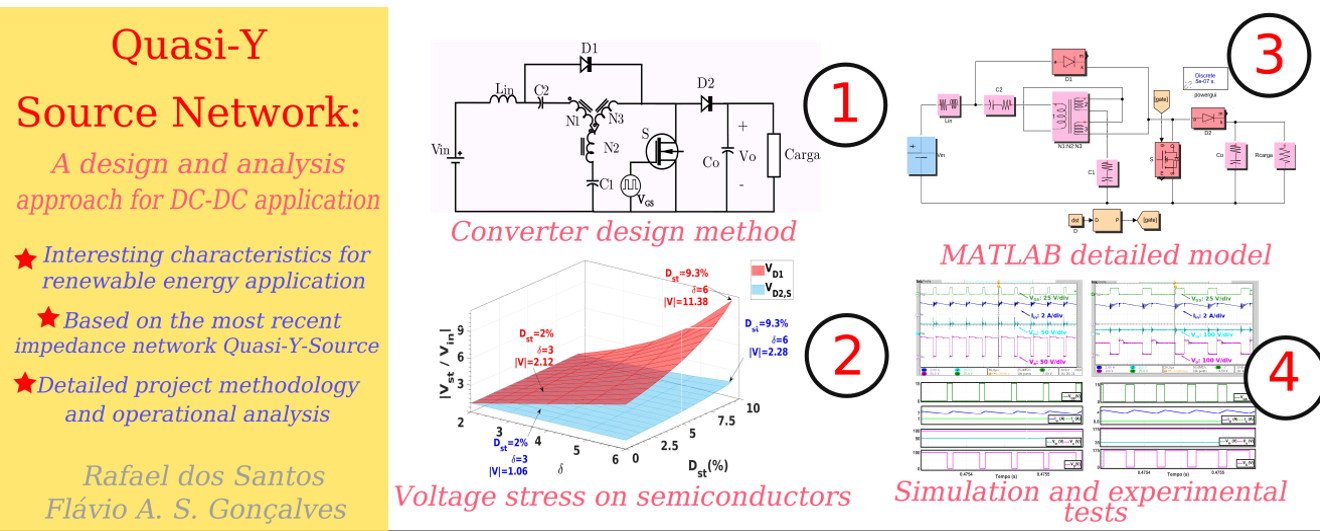Quasi-Y Source network: A design and analysis approach for a DC-DC application
Keywords:
Impedance Network, Quasi-Y, DC-DC converter, Renewable energyAbstract
This paper presents a detailed design methodology for a DC-DC converter based on the recent Quasi-Y Source impedance network, which has interesting characteristics for applications related to renewable energy sources. Despite the advantages of this particular impedance network, there is a lack in the current literature, of details regarding the design of the diode and coupled inductors, and a description of its leakage inductance impact on the performance of the Quasi-Y-Source based converter. Therefore, this work presents design guidelines for the coupled inductors including core material choice criteria and optimization of windings combinations. Several analyses are conducted, through computational simulation, with respect to voltage stresses on the converter switches. The simulations results are compared with experimental implementation considering different voltage gain B operational scenarios. The obtained results shows that the proposed approach is useful to design: (a) Quasi-Y Source DC-DC converter components; (b) Evaluate the best coupled inductors configuration; (c) Implement closed loop controllers and snubbers circuits. A discussion evaluating the converter characteristics is made, exploring possible solutions to problems related to real operation scenarios.
Downloads
References
C. Viviescas, L. Lima, F. A. Diuana, E. Vasquez, C. Ludovique, G. N. Silva, V. Huback, L. Magalar, A. Szklo, A. F. Lucena et al., “Contribution of variable renewable energy to increase energy security in latin america: Complementarity and climate change impacts on wind and solar resources,” Renewable and sustainable energy reviews, vol. 113, p. 109232, 2019.
B. K. Bose, “Power electronics, smart grid, and renewable energy systems,” Proceedings of the IEEE, vol. 105, no. 11, pp. 2011–2018, 2017.
F. Blaabjerg, R. Teodorescu, Z. Chen, and M. Liserre, “Power converters and control of renewable energy systems,” in Proc. 6th Int. Conf. Power Electron, vol. 1, 2004, pp. 1–20.
M. Forouzesh, Y. P. Siwakoti, S. A. Gorji, F. Blaabjerg, and B. Lehman, “Step-up dc–dc converters: a comprehensive review of voltage-boosting techniques, topologies, and applications,” IEEE transactions on power electronics, vol. 32, no. 12, pp. 9143–9178, 2017.
F. Z. Peng, “Z-source inverters,” Wiley Encyclopedia of Electrical and Electronics Engineering, pp. 1–11, 1999.
Y. P. Siwakoti, F. Z. Peng, F. Blaabjerg, P. C. Loh, and G. E. Town, “Impedance-source networks for electric power conversion part i: A topological review,” IEEE Transactions on power electronics, vol. 30, no. 2, pp. 699–716, 2014.
P. C. Loh and F. Blaabjerg, “Magnetically coupled impedance-source inverters,” IEEE Transactions on Industry Applications, vol. 49, no. 5, pp. 2177–2187, 2013.
P. C. Loh, D. Li, and F. Blaabjerg, “γ-z-source inverters,” IEEE transactions on Power Electronics, vol. 28, no. 11, pp. 4880–4884, 2013.
R. Strzelecki, M. Adamowicz, N. Strzelecka, and W. Bury, “New type t-source inverter,” in 2009 Compatibility and Power Electronics. IEEE, 2009, pp. 191–195.
W. Qian, F. Z. Peng, and H. Cha, “Trans-z-source inverters,” IEEE transactions on power electronics, vol. 26, no. 12, pp. 3453–3463, 2011.
M.-K. Nguyen, Y.-C. Lim, and Y.-G. Kim, “Tz-source inverters,” IEEE Transactions on Industrial Electronics, vol. 60, no. 12, pp. 5686–5695, 2012.
M. Adamowicz, “Lcct-z-source inverters,” in 2011 10th International Conference on Environment and Electrical Engineering. IEEE, 2011, pp. 1–6.
Y. P. Siwakoti, P. C. Loh, F. Blaabjerg, and G. Town, “Y-source impedance network,” in 2014 IEEE Applied Power Electronics Conference and Exposition-APEC 2014. IEEE, 2014, pp. 3362–3366.
Y. P. Siwakoti, F. Blaabjerg, and P. C. Loh, “Quasi-y-source boost dc–dc converter,” IEEE Transactions on Power Electronics, vol. 30, no. 12, pp. 6514–6519, 2015.
O. Abdelaal, M. A. Ismeil, and M. Orabi, “Model predicitve control of quasi y-source inverter,” in 2019 21st International Middle East Power Systems Conference (MEPCON). IEEE, 2019, pp. 478–483.
M. M. Haji-Esmaeili and E. Babaei, “Quasi-y source based buck-boost dc-dc converter,” in IECON 2017-43rd Annual Conference of the IEEE Industrial Electronics Society. IEEE, 2017, pp. 8033–8038.
L. Palma, “Quasi-y-source and quasi-z-source dc-dc converter comparison for pv applications,” in 2020 International Symposium on Power Electronics, Electrical Drives, Automation and Motion (SPEEDAM). IEEE, 2020, pp. 727–732.
E. Shehata, J. Thomas, A. Brisha, and M. Wageh, “Design and analysis of a quasi y-source impedance network dc-dc converter,” in 2017 Nineteenth International Middle East Power Systems Conference (MEPCON). IEEE, 2017, pp. 235–241.
E. Shehata, “Predictive control of a new configuration of bidirectional quasi y-source inverter fed ipmsm for electric vehicle applications,” in 2017 Nineteenth International Middle East Power Systems Conference (MEPCON). IEEE, 2017, pp. 287–292.
P. B. Borkar and A. Chowdhury, “Analysis of quasi y source inverter with maximum boost control technique,” in 2017 National Power Electronics Conference (NPEC). IEEE, 2017, pp. 19–24.
X. Fang, X. Ding, S. Zhong, and Y. Tian, “Improved quasi-y-source dc-dc converter for renewable energy,” CPSS Transactions on Power Electronics and Applications, vol. 4, no. 2, pp. 163–170, 2019.
H. Liu, Y. Li, K. Liu, P. C. Loh, W. Wang, D. Xu, and F. Blaabjerg, “Extended quasi-y-source inverter with suppressed inrush and leakage effects,” IET Power Electronics, vol. 12, no. 4, pp. 719–728, 2018.
R. W. Erickson and D. Maksimovic, Fundamentals of power electronics. Springer Science & Business Media, 2007.
L. R. Diana, “Practical magnetic design: Inductors and coupled inductors,” in Power Supply Design Seminar. Texas Instruments, 2012.
Y. P. Siwakoti, P. C. Loh, F. Blaabjerg, and G. E. Town, “Effects of leakage inductances on magnetically coupled y-source network,” IEEE Transactions on Power Electronics, vol. 29, no. 11, pp. 5662–5666, 2014.
N. Semiconductors, “An11160-designing rc snubbers,” Application note, Rev, vol. 1, no. 04, 2012.
C. Moßlacher and L. G ¨ orgens, “Simple design techniques for optimizing ¨ efficiency and overvoltage spike of synchronous rectification in dc to dc converters,” in Proc. PCIM, 2010.
R. Doebbelin and A. Lindemann, “Leakage inductance determination for transformers with interleaving of windings,” PIERS Online, vol. 6, no. 6, pp. 527–531, 2010.
S. Ahmadzadeh, G. A. Markadeh, and F. Blaabjerg, “Voltage regulation of the y-source boost dc–dc converter considering effects of leakage inductances based on cascaded sliding-mode control,” IET Power Electronics, vol. 10, no. 11, pp. 1333–1343, 2017.


